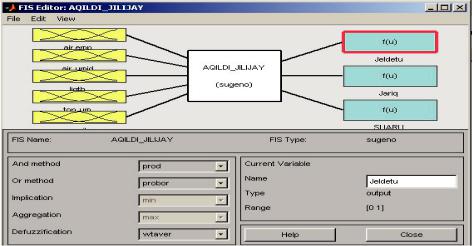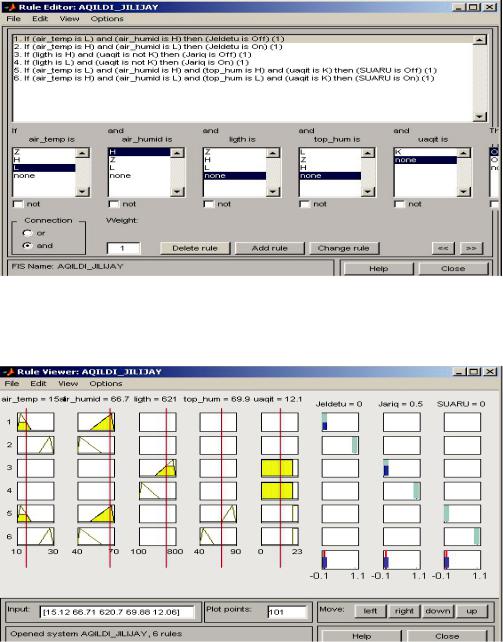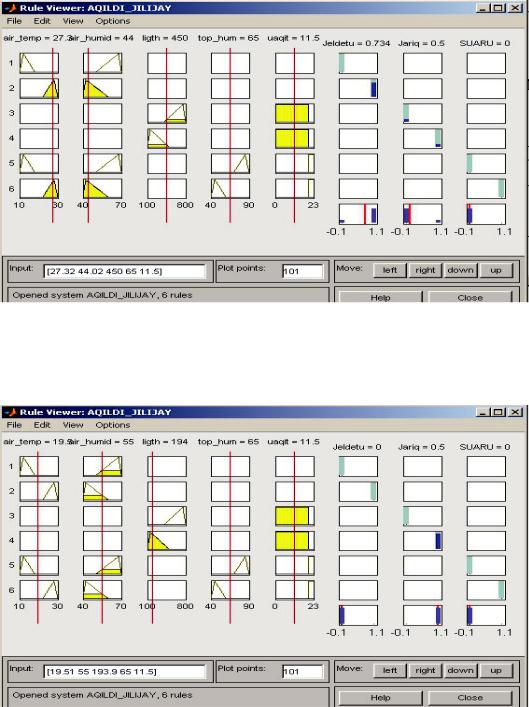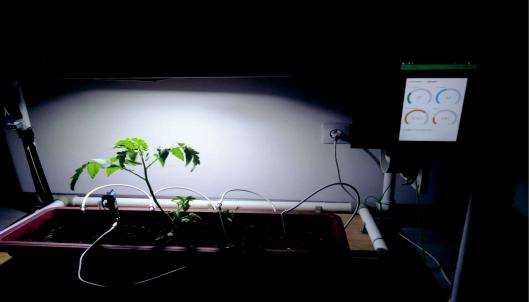
76
.pdf
Belgibaev B.A. et al. |
181 |
where ( ) is the operation from the s-norm (t-norm), that is, from the set of implementation: for the operation OR (AND). The following operations are most often used: OR – finding the maximum, AND – finding the minimum.
The output of model y is determined by a linear combination:
y = bj,0 + bj,1 · x1 + bj,2 · x2 + . . . + bj,n · xn, j = |
1, m, |
(4) |
where bj,i are some numbers.
In the model under consideration (Zero-order Sugeno), the conclusions of the Knowledge Base rules are given by functions in which all the coe cients of the input variables in the linear "input-output" laws are equal to zero. The output of model (2) – (4) y = bj , j = 1, m
correspond to the control signals u1(t), u2(t), u3(t) of the NLC (Fig. 2 and 3), i.e. |
|
y = {u1(t); u2(t); u3(t)}. |
(5) |
Let us consider in more detail the operation algorithm of the control unit. The basis of UU is the Knowledge Base, which contains the Databases and the Rule Base. The initial Rule Base is set by an expert. The process of the system includes three stages: Monitoring data; Signal transmission via WiFi/Bluetooth; Management (data processing using NLC).
At the first start-up, in the conditions of an operating greenhouse, the Database is filled with actual values characterizing the state of the microclimate. After filling in the database of previous states and the rule base, the system goes into the operating mode of controlling the microclimate of the greenhouse.
Table 1 provides a description of the linguistic variables of the model (2) – (5). The model has 5 inputs and 3 outputs. Since air temperature and air humidity are measured by one DHT11 sensor, these two physical quantities are denoted by the same variable x1(t). The fourth variable is the start time of the irrigation system tzap.
Table 1: Linguistic variables and their scope
Linguistic |
vari- |
Variable Range |
Type of member- |
Variable designa- |
|
ables |
|
|
and their intervals |
ship function |
tion |
|
|
|
I n p u t s – X = |
{x1(t), x2(t), x3(t), t} |
|
Air |
temperature |
L = [10, 12, 18]; |
Triangular |
x1(t) |
|
(air_temp), C |
Z = [16, 20, 24]; |
|
|
||
|
|
|
H = [22, 28, 30] |
|
|
|
|
|
|
|
|
Air |
humidity |
L = [40,42,60]; |
Triangular |
x1(t) |
|
(air_hum) % |
|
Z = [45,55,65]; |
|
|
|
|
|
|
H = [50,68,70] |
|
|
Light (light), lk |
L = [100,150,500]; |
Triangular |
x2(t) |
||
|
|
|
Z = [300,450,600]; |
|
|
|
|
|
H = [400,750,800] |
|
|
Irrigation |
time |
t_zap = 20:00; |
Singleton |
t |
|
(uakit), hour |
|
(Runs at 20:00) |
|
|
|
Soil |
humidity |
L = [40,45,60]; |
Triangular |
x3(t) |
|
(top_hum), % |
Z = [50,65,80]; |
|
|
||
|
|
|
H = [70,85,90] |
|
|

182 |
Designing smart greenhouses, satisfactory price-quality . . . |
O u t p u t s – y = {u1(t); u2(t); u3(t)}
Actuator |
1, |
{0; 1} |
Singleton |
u1(t) |
On/O |
|
|
|
|
Actuator |
2, |
{0; 1} |
Singleton |
u2(t) |
On/O |
|
|
|
|
Actuator |
3, |
{0; 1} |
Singleton |
u3(t) |
On/O |
|
|
|
|
The purpose of the NLC is to develop control actions u1(t), u2(t), u3(t) for the corresponding actuator based on the monitoring data x1(t), x2(t), x3(t) and the built-in rules of the Expert Knowledge Base described in Table 2.
Table 2: Rules from the Knowledge Base
|
IF |
THEN |
Rule 1 |
air_temp is Low AND air_hum is Hi |
Actuator 1 is On |
Rule 2 |
air_temp is Hi AND air_hum is Low |
Actuator 1 is O |
Rule 3 |
light is Hi AND uaqit is NOT K |
Actuator 2 is O |
Rule 4 |
light is Low AND uaqit is NOT K |
Actuator 2 is On |
Rule 5 |
air_temp is Low AND air_hum is Hi |
Actuator 3 is O |
|
AND top_hum is Hi AND uaqit is K |
|
Rule 6 |
air_temp is Hi AND air_hum is Low |
Actuator 3 is On |
|
AND top_hum is Low AND uaqit is K |
|
Table 3 shows the results of monitoring using the system "Home smart greenhouse". They are obtained using the signal sensors of the ESP 32 Transmitter (see paragraphs 2.3 and 2.4). The monitoring process was carried out for 162 hours (database update frequency – every 3 hours).
Table 3: Monitoring results using the "Home smart greenhouse" system
Air tempera- |
Air humidity, |
Light, lk |
Soil humidity, |
Irrigation |
ture, |
% |
|
% |
time (h) |
16 |
63 |
0 |
55 |
0 |
15 |
70 |
0 |
58 |
3 |
13 |
82 |
136 |
52 |
6 |
14 |
82 |
375 |
48 |
9 |
17 |
66 |
476 |
42 |
12 |
18 |
64 |
524 |
40 |
15 |
19 |
65 |
497 |
45 |
18 |
20 |
56 |
464 |
66 |
21 |
14 |
44 |
0 |
62 |
24 |
14 |
68 |
0 |
60 |
0 |
13 |
73 |
0 |
57 |
3 |
Belgibaev B.A. et al. |
183 |
13 |
68 |
117 |
52 |
6 |
18 |
60 |
321 |
55 |
9 |
20 |
59 |
476 |
50 |
12 |
20 |
57 |
424 |
51 |
15 |
20 |
65 |
222 |
62 |
18 |
14 |
60 |
316 |
81 |
21 |
15 |
78 |
0 |
72 |
24 |
15 |
78 |
0 |
70 |
0 |
14 |
73 |
0 |
65 |
3 |
13 |
70 |
117 |
60 |
6 |
20 |
58 |
321 |
58 |
9 |
22 |
54 |
408 |
55 |
12 |
21 |
63 |
363 |
48 |
15 |
20 |
65 |
190 |
53 |
18 |
19 |
58 |
460 |
68 |
21 |
14 |
74 |
0 |
64 |
24 |
14 |
74 |
0 |
63 |
0 |
11 |
70 |
0 |
60 |
3 |
11 |
61 |
195 |
57 |
6 |
18 |
49 |
536 |
50 |
9 |
22 |
44 |
680 |
45 |
12 |
24 |
41 |
606 |
50 |
15 |
24 |
42 |
318 |
53 |
18 |
21 |
56 |
470 |
58 |
21 |
13 |
55 |
0 |
62 |
24 |
13 |
55 |
0 |
60 |
0 |
12 |
44 |
0 |
57 |
3 |
10 |
39 |
195 |
54 |
6 |
20 |
38 |
536 |
49 |
9 |
26 |
31 |
680 |
45 |
12 |
27 |
32 |
606 |
48 |
15 |
27 |
36 |
593 |
47 |
18 |
25 |
48 |
568 |
52 |
21 |
16 |
45 |
0 |
55 |
24 |
16 |
45 |
0 |
57 |
0 |
16 |
44 |
0 |
60 |
3 |
15 |
38 |
195 |
63 |
6 |
24 |
32 |
536 |
60 |
9 |
28 |
31 |
680 |
53 |
12 |
29 |
29 |
363 |
50 |
15 |
20 |
42 |
338 |
55 |
18 |
16 |
59 |
316 |
81 |
21 |
19 |
37 |
0 |
78 |
24 |

184 |
Designing smart greenhouses, satisfactory price-quality . . . |
4 Results and discussions
The simulation results are reflected in the form of the NLC structure (Fig. 4), the rules of the Knowledge Base (Fig. 5), the values of the fuzzy logical inference of the system for three IM1, IM2 and IM3 (Fig. 6, 7, 8 and 9).
NLC is a Multi Input Multi Output (MIMO) system in which there are 5 inputs and 3 outputs (Fig. 4). Inputs: Air Temperature, Humidity, Illumination, Soil Humidity and Watering Time. Outputs: state IM1, IM2 and IM3 (see Table 2). The Knowledge Base contains 6 rules (see Table 3).
Figure 4: The structure of the NLC model in Matlab
An example of creating a Knowledge Base based on Table 3 in the Matlab environment is shown in Fig. 5. Here the variable On means to turn on the corresponding IM, the variable O to turn o the corresponding IM.
Let us explain the calculated control values in Fig. 6-9.
For example, with an input vector x1 = {15.12; 66.71; 620.7; 69.88; 12.06} NLC output y1 = {u1 = 0; u2 = 0.5; u3 = 0} (rule 1 is fulfilled, that is, at low air temperature and high air humidity – the fan must be turned o and rule 3, that is, at high daylight – the projector must be turned o ).
With |
the input vector x2 = {27.32; 44.02; 450; 65; 11.5} NLC output y2 = {u1 = |
0.734; u2 |
= 0.5; u3 = 0} (rule 2 is fulfilled, that is, high air temperature and low air hu- |
midity – the fan must be turned on).
With the input vector x3 = {19.51; 55; 193.9; 65; 11.5} NLC output y3 = {u1 = 0; u2 = 0.5; u3 = 0} (rule 4 is satisfied, that is, during the day in low light – the spotlight must be turned on).
For example, with an input vector X4 = {27.8; 44.76; 193.9; 46.71; 22.16} NLC output y4 = {u1 = 0.53; u2 = 0.5; u3 = 0} (rule 2 is fulfilled, that is, at high air temperature and low air humidity – the fan must be turned on and rule 6, that is, at high air temperature and low air humidity and low soil moisture after 20:00 hours – the irrigation valve must be enable).




188 |
Designing smart greenhouses, satisfactory price-quality . . . |
Figure 11: Mobile application "Akyldy zhylyzhay" , in the process of work
5 Conclusion
The paper proposes an approach to the development of the Home Smart Greenhouse system, the control device of which is implemented on the basis of NLC in the form of the Sugeno model. The system allows you to perform:
1)control (monitoring) of the microclimate processes in Online mode;
2)fuzzy control in manual and automatic mode;
3)adjust the parameters of the three microclimate processes: cooling, watering and light-
ing.
The main element of the system is a control device based on NLC. The device is based on the ESP 32 microcontroller using wireless networks and web technology (WSN, IoT) and fuzzy control.
The described NLC model adequately reflects the microclimate control process in the greenhouse. As a result of using the system, the productivity of the farmer user is increased, thereby helping the farmer user control the plant growth process and take the necessary measures to care for them.
The developed system meets the criterion of price-quality. The cost of the system is 86.75 (the price is not higher than the minimum wage of Kazakhstan), the economic e ect of using the system is 25, the payback period of the greenhouse is 4 seasons.
Belgibaev B.A. et al. |
189 |
References
[1]Amantur Umarov, Murat Kunelbayev, Maksat Satymbekov et al., "Micro climate Monitoring System For A Home Greenhouse As Part Of ESP32" , International Conference on Renewable Energy & Emerging Technologies (ICREET) 2019. doi:0.1617/vol6iss11pid101035.
[2]Carlos Robles, Jes´us Callejas, Aura Polo, "Low-Cost Fuzzy Logic Control for Greenhouse Environments with Web Monitoring" , Electronics 6, 71, 2017. doi:10.3390/electronics6040071.
[3]Didi Faouzi, N. Bibi-Triki, B. Draoui, A. Abene, "Modeling and simulation of fuzzy logic controller for optimization of the greenhouse microclimate management" , Agricultural science and technology Vol. 9, No 2, 2017. doi: 10.15547/ast.2017.02.024.
[4]Doaa M. Atia, Hanaa T., "El-madany Analysis and design of greenhouse temperature control usingadaptive neuro-fuzzy inference system" , Journal of Electrical Systems and Information Technology 4 (2017): 34-48.
[5]Georgios Nikolaou, Damianos Neocleous, Nikolaos Katsoulas, Constantinos Kittas, "Irrigation of Greenhouse Crops" , Horticulturae 5, 7, 2019. doi:10.3390/horticulturae5010007.
[6]Giuseppina Nicolosi, Roberto Volpe, Antonio Messineo, "An Innovative Adaptive Control System to Regulate Microclimatic Conditions in a Greenhouse" , Energies 10, 722, 2017. doi:10.3390/en10050722.
[7]Ishak S.N., Abd Malik N.N., Abdul Lati N.M. et. al. "Smart Home Garden Irrigation System Using Raspberry Pi" ,
IEEE 13th Malaysia International Conference on Communications (MICC) (2017).
[8]Jirapond Muangprathub, Nathaphon Boonnam, Siriwan Kajornkasirat, Narongsak Lekbangpong, Apirat Wanichsombat, Pichetwut Nillaor, "IoT and agriculture data analysis for smart farm" , Computers and Electronics in Agriculture 156 (2019): 467-474.
[9]Kais Said, Qays Jebur, "Design a Multi-Choice Fuzzy Control System of the Greenhouse" , Journal of Engineering Volume 21-2 (2015): 103-118.
[10]Klapwijk D., "Kasklimaat plantengroei en groeibeheersing onder glas [Microclimate and plant growth management]" ,
Amsterdam: Elsevier (1971).
[11]Lukas Bajer, Ondrej Krejcar, "Design and Realization of Low Cost Control for Greenhouse Environment with Remote Control" , IFAC-PapersOnLine 48-4 (2015): 368-373.
[12]Manel Jomaa, Mehdi Abbes, Fernando Tadeo, Abdelkader Mami, "Greenhouse Modeling, Validation and Climate Control based on Fuzzy Logic" , Engineering, Technology & Applied Science Research Vol. 9, No. 4 (2019): 4405-4410.
[13]Mustafa Alper Akka¸c, Radosveta Sokullu, "An IoT-based greenhouse monitoring system with Micaz motes" , Procedia Computer Science 113 (2017): 603-608.
[14]Rafiuddin Syam, Wahyu H. Piarah and Budi Jaelani, "Controlling Smart Green House Using Fuzzy Logic Method" ,
International Journal on Smart Material and Mechatronics Vol. 2 No. 2 (2015).
[15]Reallab, "Sistema kontrolya i upravleniya mikroklimatom v ovoshchekhranilishche "Agroterm" [Climate control and management system in the vegetable store "Agroterm"]" , Nauchno-issledovatel’skaya laboratoriya avtomatizacii i proektirovaniya Automation and Design Research Laboratory] https://www.reallab.ru/.
[16]Revathi S., Sivakumaran N., "Fuzzy Based Temperature Control of Greenhouse" , IFAC-PapersOnLine 49 (1) (2016): 549-554.
[17]Richard Grabowski, "The failure of import substitution: Reality and myth" , Journal of Contemporary Asia Vol. 24, Issue 3, 1994. https://doi.org/10.1080/00472339480000181.
[18]Shtovba S.D., "Proektirovanine nechenkih sistem sredstvami Matlab [Designing fuzzy systems using Matlab]" , Мoscow: Telekom (2007).
[19]Mohamed S., Hameed I.A., "A GA-Based Adaptive Neuro-Fuzzy Controller for Greenhouse Climate Control System" ,
Alexandria Engineering Journal 57 (2015): 773-779.
[20]"Smart greenhouse last edited 16 Sep 2018, https://www.designingbuildings.co.uk/wiki/Smart_greenhouse.
[21]Siemens AG 2018, Greenhouse control with Simatic S7-1200. Entry ID: 109757060, Vol 1, 05/2018. http://www.support.industry.siemens.com/cs/ww/en/view/109757060.
